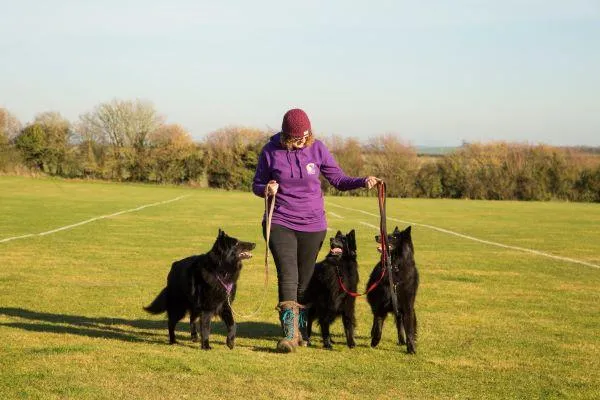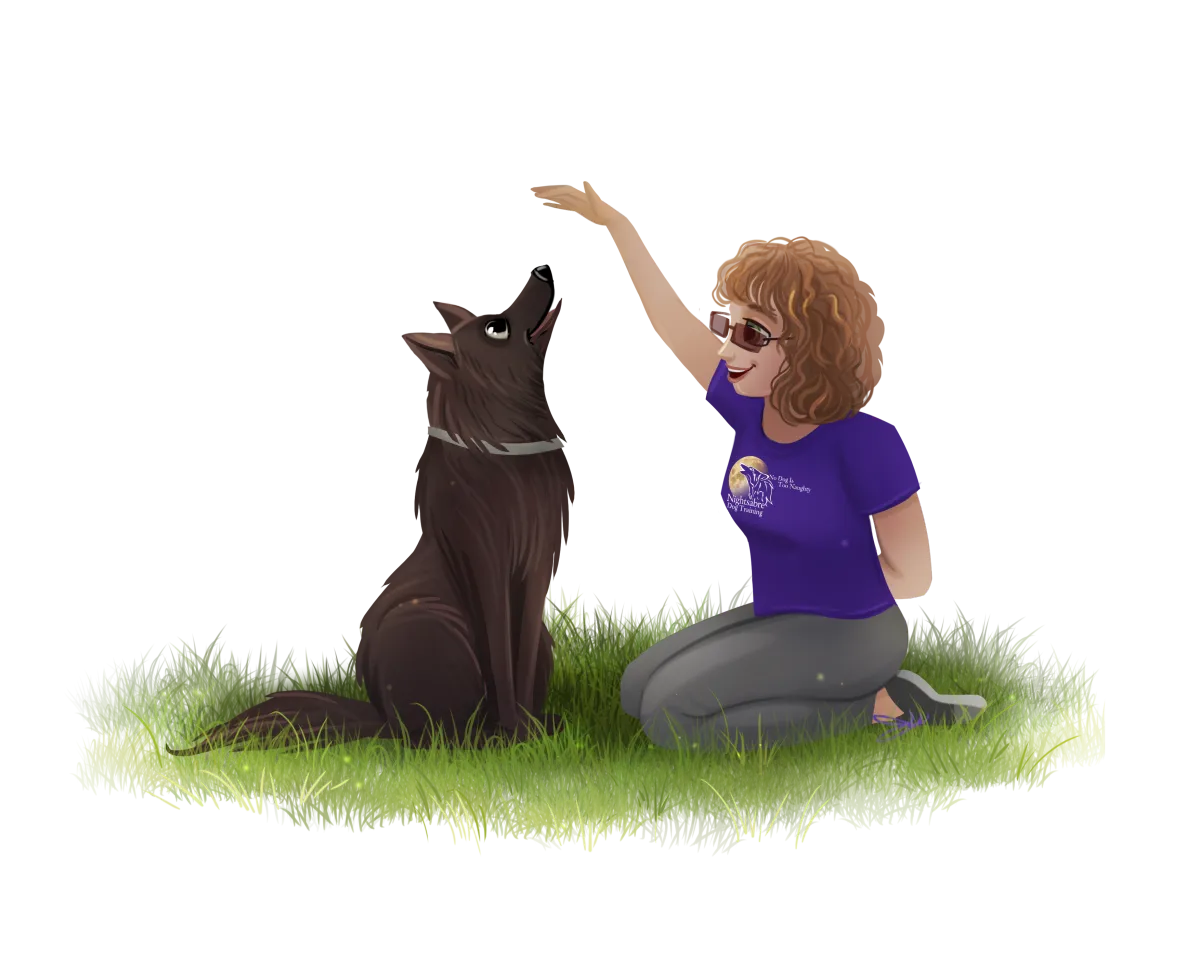The Fastest Way to Train a Dog: Positive Reinforcement Techniques for Success
Discover the fastest way to train your dog using positive reinforcement, with tips for obedience training stubborn breeds and using marker words effectively.
07888 870151

Discover the fastest way to train your dog using positive reinforcement, with tips for obedience training stubborn breeds and using marker words effectively.

“Living with a high-drive dog isn’t about exhausting them into submission—it’s about working with their energy, not against it. By balancing physical exercise, mental engagement, and emotional fulfillment, you don’t just get a well-behaved dog—you get a loyal, driven companion who thrives by your side.”
If you’ve ever lived with a high-drive dog, you know the experience is both exhilarating and exhausting. These dogs don’t just walk through life—they charge at it full speed ahead. They thrive on activity, engagement, and purpose. But when their needs aren’t met, that same enthusiasm can turn into relentless barking, destructive chewing, and boundless frustration—for both of you. So how do we bridge the gap between their intense energy and a peaceful, well-balanced life? It starts with understanding what makes them tick.
It’s easy to misjudge what a high-drive dog really needs. Plenty of well-meaning owners make the same mistakes—mistakes that seem harmless at first but can lead to unwanted behaviors down the road.
You might think, “I took my dog on an hour's walk today. That should be enough, right?” But here’s the thing—one leisurely stroll around the block is like giving an elite athlete a single push-up and calling it a workout. These dogs need movement with intention—think structured agility drills, flirt pole sessions, or even scent work as well as their daily walk. But here’s the catch—too much physical exercise without mental balance can create a monster. When dogs are constantly pushed to their physical limits, they build endurance rather than satisfaction, requiring even more exercise to reach the same level of tiredness. It’s a vicious cycle that leaves both the dog and the owner feeling drained. Instead of relying solely on physical exertion, the key is a balanced mix of physical and mental stimulation to truly meet their needs and encourage relaxation.
Physical exercise is just half the equation. If their brains aren’t challenged, high-drive dogs will find their own entertainment—and you probably won’t like their version. I learned this lesson the hard way with my first Belgian Shepherd, Shadow. One day, I popped out to the shops, thinking nothing of it. When I returned, I found my textbooks—every single one—torn to shreds on the floor. And the irony? Those textbooks were for a dog behavior course! That was Shadow’s way of telling me she was bored and needed more mental engagement. These dogs crave problem-solving, which means puzzles, scent work, trick training, and interactive games are just as important as their daily run.
What worked for your neighbor’s laid-back Golden Retriever isn’t going to cut it for a Malinois or a Border Collie. High-drive dogs require a different training approach—one that embraces their intensity rather than fights against it. If you’re using the same methods you used for a couch-potato pup, you might be feeling frustrated. But the good news? With the right techniques, you can channel that drive into something amazing.
Owning a high-drive dog isn’t just about managing their energy—it’s about managing our own reactions to that energy. Because let’s be honest, these dogs can be a lot. And it’s not just about their endless enthusiasm; it’s also about how we, as owners, respond to it. Take my household, for example—I thrive on the energy of a dog that’s always on the go, but my partner? He prefers a dog that can settle. If our dog is bouncing off the walls, I see it as an opportunity for engagement, whereas he feels overwhelmed and stressed. This difference in perspective can make high-drive dogs feel even more challenging, especially when you’re constantly wondering if you’re doing enough or if their energy is too much to handle.The three questions below are the ones I hear most from owners with high-drive dogs.
This is probably the biggest fear. You want your dog to be happy, but how do you know if you’re providing enough? The reality is, it’s not about constant activity—it’s about balance. A combination of structured training, interactive play, and downtime will help your dog thrive without running you into the ground.
High-drive dogs can be intense. They see a squirrel, and suddenly, they’re in another dimension. They get excited, and suddenly, you’re water skiing behind them on the leash. But it’s not just their prey or chase drive that can make things challenging—without proper socialization, these dogs can also become reactive. Reactivity isn’t always about aggression; sometimes, it stems from frustration or overstimulation. The fear of embarrassment—or worse, an accident—can make outings stressful. But here’s the thing: with impulse control training, clear boundaries, and positive exposure to different environments, you can teach them how to manage that intensity without losing their spark.
That barking, lunging, or chasing instinct—it can feel like it’s escalating. And when that happens, some owners retreat, avoiding social settings or training sessions altogether. But avoidance doesn’t fix the problem—addressing their unmet needs does. A lot of the time, behaviours worsen not because the dog is being difficult, but because their physical, mental, and emotional needs aren’t being met. It’s not just about structured training; it’s about creating balance in all aspects of their life. When a dog’s needs are fulfilled holistically, their behaviour improves naturally, making training more effective and their energy more manageable.
At the end of the day, we all want the same thing: a dog who fits into our lives without constant chaos. A dog who listens, engages, and—most importantly—finds fulfillment in the partnership we build with them.
No one wants to live with a whirlwind of fur and destruction. A well-balanced high-drive dog knows when it’s time to work and when it’s time to settle. That’s the sweet spot we’re aiming for—enthusiastic and engaged when needed, but also capable of calm behaviour and relaxation when required.
These dogs aren’t just pets—they’re athletes, thinkers, and partners. Keeping their bodies and minds engaged isn’t just about preventing problem behaviours; it’s about allowing them to thrive. A dog who gets all their needs met is confident, fulfilled, and an absolute joy to be around.
There’s nothing quite like the connection between a handler and their high-drive dog. When you become their source of guidance, fun, and fulfillment, they start looking to you for direction—not just reacting to their instincts. That kind of loyalty and trust? It makes all the effort worth it.
If you’re struggling with certain behaviours, your dog is trying to tell you something. Their energy has to go somewhere—if it’s not being directed productively, it will manifest in ways you won’t like. This is so typical of the Belgian Shepherds that I share my life with, and I wouldn’t have it any other way! Their endless drive keeps me on my toes, but it also makes them the incredible, passionate companions that they are. Understanding and embracing that energy is the key to building a fulfilling life together.
If your dog won’t stop making noise, it’s important to understand why. If you have a high-drive guarding or herding breed, inappropriate barking may stem from their natural guarding instinct. It’s up to us to teach them when guarding is appropriate and when it is not. Barking can also be a sign of boredom, attention-seeking, being under or over-stimulated, or even fear—especially in dogs that are highly sensitive or anxious. The key is to identify the root cause and adjust their routine accordingly, ensuring they have the right balance of structure, engagement, and emotional support.
Your dog isn’t trying to ruin your life when they destroy the furniture—they’re just looking for an outlet. Destructive behaviors like chewing and digging are often linked to boredom, but the root cause can go deeper. A lack of proper balance between physical exercise, mental engagement, and emotional fulfillment can leave them frustrated and searching for ways to release that energy. The key is to provide enrichment in all areas—give them something better to do, like a frozen Kong, a snuffle mat, or a structured training session, and ensure their emotional needs are met as well.
If your dog is still pacing and looking for more things to do after exercise, they need something different, not necessarily more. That’s where mental stimulation, structured downtime, and decompression exercises come in.

Rotate activities: Variety keeps things interesting. Mix high-energy games with obedience training and brain teasers. But it’s not just about switching up activities—it’s also important to expose them to different places and environments. Taking your dog to new locations challenges their brain in new ways, helping them adapt, build confidence, and stay engaged in their training.
Teach impulse control: Impulse control goes beyond simple commands like "wait," "leave it," and "place." While these are useful tools, the real goal is to teach your high-drive dog to self-regulate rather than rely on constant direction. Instead of always having to tell them to leave something alone, they should learn that making the right choice on their own leads to the rewards they want. By reinforcing the idea that calmness and patience bring good things—whether it’s access to a toy, food, or an activity—you help them develop true impulse control that lasts beyond structured training sessions.
Use positive reinforcement techniques: Reward-based training builds confidence and makes learning fun, but it’s essential to identify what your high-drive dog finds truly rewarding. Cassie, for example, will take treats in some situations, but what she really loves is a good, quick game of tuggy or catching a ball. For her, play is far more valuable than a food reward. When using positive reinforcement, understanding what motivates your dog is key to making training more effective and enjoyable for both of you.
Encourage rest: Not every moment has to be action-packed. We often call this teaching the dog an 'off switch.' This can be achieved by alternating high-energy exercise with calmness training. Teaching them that settling down is just as rewarding as being active helps create a well-balanced, adaptable dog.

Living with a high-drive dog isn’t about exhausting them into submission—it’s about working with their energy, not against it. When you provide the right balance of structure, engagement, and relaxation, you don’t just get a well-behaved dog—you get a loyal, driven companion who’s truly fulfilled.
Looking for a fun and structured way to engage your high-drive dog? Join my Rally Obedience class! It’s a fantastic way to build focus, strengthen your bond, and channel their energy in a positive direction. Sign up here: Rally Obedience Class.

Fun | Focus | Play® by Nightsabre Dog Training
Natasja Lewis DipCAPBT | 07888 870151 | [email protected]
Nightsabre Dog Training © 2023/2024/2025 . Privacy Policy